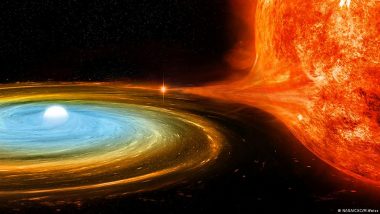Gearing up to witness the nova explosion of T Coronae Borealis this September? It promises to be a once-in-a-lifetime astronomical event.It's not often that a dark spot in space illuminates our planet, but that is exactly what professional and amateur astronomers expect to happen in September when a once-in-a-lifetime nova explosion 3,000 light-years from Earth will light up our night sky.
Also Read | NASA Successfully Launches GOES-U Satellite To Monitor Weather in Space, Earth and Solar Storms.
What is a nova explosion?
Also Read | What is Oropouche Fever?.
A nova explosion is the dramatic instance of a star exploding as it interacts with another, nearby star. It's a one of many, repeated moments during the long, slow, death of two neighboring stars in the same system.
Astronomers are waiting for the fiery explosion of T Coronae Borealis, also dubbed the "Blaze Star" and known to astronomers as "T CrB".
The system contains two stars — a white dwarf and a red giant. The white dwarf is an incredibly dense remnant of a once larger star. It's about the size of planet Earth but with the same mass as our Sun.
Its neighbor, the red giant, is in its final years of existence and is slowly being stripped of hydrogen by the gravitational pull of the denser white dwarf.
This star "cannibalism" causes a tremendous buildup of pressure and heat, which eventually triggers a huge thermonuclear explosion. The explosion doesn't completely destroy the stars, however, and so this event repeats over time. It can carry on for hundreds of thousands of years.
For T CrB, this nova event happens roughly every 80 years — it's a like Halley's Comet event every 76 years — so, astronomers call T CrB a "recurrent" nova.
They believe T CrB's prior eruptions were observed as long ago as December 1787 and even October 1217 AD.
Is a nova the same as a supernova?
No. A supernova is the final explosion that utterly destroys stars. In a nova event, the dwarf star remains intact, which is why nova events typically repeat themselves.
Different nova events have different cycles, ranging from a few years to hundreds of thousands of years.
What does a nova look like?
The explosion of a nova blasts away star matter in a blinding light, but it won't look like a star explosion you see in the movies — thankfully, we're too far away to see this level of detail.
To the naked eye, the nova will instead look like a new star has appeared in the sky. People with high-powered telescopes will be able to see the nova's brightly colored luminosity in some detail.
Will we be able to see the nova without a telescope?
Yes! When T CrB erupts, its luminosity will increase dramatically, making it visible to the naked eye for several days.
The Northern Crown is a horseshoe-shaped curve of stars west of the Hercules constellation, ideally spotted on clear nights.
To find the Northern Crown, locate the two brightest stars in the Northern Hemisphere: Arcturus and Vega. Tracing a line between the two stars will lead you to the Northern Crown, where T CrB lies.
The European Space Agency told DW that all telescopes were already pointing towards T CrB, waiting to capture the event, but that there are no images as yet.
When will the nova be visible?
All signs point to the nova explosion happening in September 2024. However, novae can be unpredictable, so astrophysicists say it's difficult to know exactly when the T CrB nova will occur.
Have nova events been seen during history?
T CrB nova was last seen from Earth in 1946. The first recorded sighting of the T CrB nova was believed to be more than 800 years ago in 1217, when an abbot in the town of Ursberg, Germany, noted "a faint star that for a time shone with great light."
The abbot wrote the light lasted for "many days” and was thought to be a "wonderful sign." Other celestial events like comets were believed to be bad omens.
Astronomers have recorded supernova events much further back in history. The first sighting of a supernova goes back almost 2000 years to 185 CE, when Chinese astronomers saw a strange "guest star" appear in the night sky for eight months.
Edited by: Zulfikar Abbany
Sources:
NASA Astrophysics https://science.nasa.gov/astrophysics
NASA, Global Astronomers Await Rare Nova Explosion, June 2024 https://www.nasa.gov/centers-and-facilities/marshall/nasa-global-astronomers-await-rare-nova-explosion/
The recurrent nova T CrB had prior eruptions observed near December 1787 and October 1217 AD. Journal for the History of Astronomy, November 2023 https://doi.org/10.1177/00218286231200492
(The above story first appeared on LatestLY on Jun 26, 2024 04:20 PM IST. For more news and updates on politics, world, sports, entertainment and lifestyle, log on to our website latestly.com).













 Quickly
Quickly




















